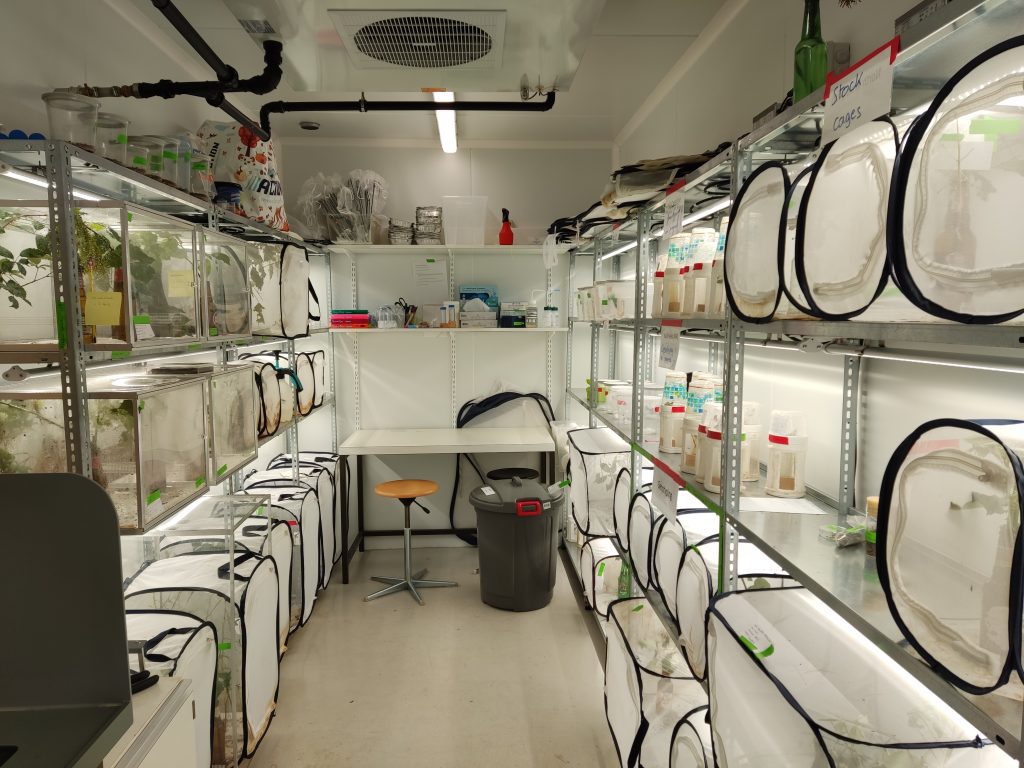
A view into one of our stick insect breeding rooms at the Department of Ecology and Evolution, University of Lausanne.
This project has received funding from the European Union’s Horizon 2020 research and innovation programme under the Marie Sklodowska-Curie grant agreement No 101024860.
New preprint on Bacillus stick insects out (embedded below):
Bacillus stick insects utilise many different ways to produce offspring. Some Bacillus species are strictly sexual, like mammals. Their offspring develops from a zygote, formed by fusion of an egg with a sperm cell. The female that produces the egg always transmits a mixture of genetic material that it has derived from its mother and its father (as does the male that produces the sperm).
Some Bacillus species are strictly asexual and reproduce via thelytokous parthenogenesis -“virgin birth”-, where female offspring develops from an unfertilised egg. There is no sperm needed. The female that produces the egg transmits only genetic material that it has derived from its mother (because it had no father itself).
Some Bacillus species can even do both: if there is no male around to contribute sperm, the eggs start to develop asexually. But it gets even more confusing…
… some hybrid Bacillus species utilize particularly complex reproductive strategies called hybridogenesis and androgenesis. These hybrid Bacillus have originated a long time ago when two very different Bacillus species “erroneously” engaged in mating with each other. Hybridogenesis weirdly combines features of both sexual and asexual reproduction. Asexual in the sense that the egg cells produced by a female contain only maternal genetic material that has been derived from the mother of the very first hybrid cross. The paternal genetic material that has been derived from its father is somehow recognised and completely eliminated from the egg. However, it gets renewed each generation because the female is mating with males of the paternal species, reestablishing the hybrid state. Therefore, hybridogenetic Bacillus species need to co-occur with a sexual species to have access to males that can provide the paternal genome.
Finally, under androgenesis, offspring bear only nuclear genes from their father (except for the mitochondrial genome), as there is no fusion between maternal and paternal genetic material in the zygote. One way to achieve androgenetic reproduction could be for example if a female lays an “empty” egg, devoid of any nuclear genetic material, by accident from time to time.
All these Bacillus species (hybrid and non-hybrid) and their complicated reproductive strategies have been described already in the early nineties. However, back then many molecular methods were still in its infancy and conclusions about hybrid state and the transmission of genetic material drawn from the studies had to remain restricted to only a few regions of the genome. In our new preprint, my colleague Guillaume and I confirm the previous findings and confirm that they actually hold valid for the whole genome of Bacillus stick insects. Also, we made some fascinating findings which we had not expected…
Because there are so many different reproductive strategies occurring in very closely related species, hybrid Bacillus are ideally suited to study the origin of alternative reproductive strategies: what are the molecular innovations that underly the origin(s) and did all the alternative reproductive strategies originate independently or was there a single loss of sex followed by several transitions, e.g. between hybridogenesis and parthenogenesis?